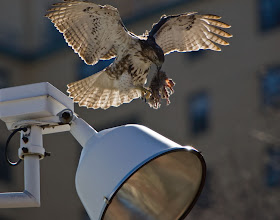
Photograph by Francois Portmann, www.fotoportmann.com/
Beautiful Valkyrie seemingly showing off her tail. Francois pointed out to me that if you look closely the ends of Valkyrie's tail feathers above the white band, they have a rufous tinge.

Photograph by Francois Portmann
Look at Valkyrie's strong focus and the command she has of her strong fluid body.

Photograph by Francois Portmann
An adult on 2nd Street with some left-over pigeon, eyeing the next one.

Photograph by Francois Portmann
An urban Crow doing what Crows love to do best, hassle Hawks. Take note a grand photograph to compare the size and shape difference between a Red-tailed Hawk and an American Crow in flight.

Photograph by Francois Portmann
Valkyrie heads for a pigeon who does a tummy up take off in order to make her get away.

Photograph by Francois Portmann
Val gains altitude.

Photograph by Francois Portmann
She does a balletic in air turn, talons at the ready.

Photograph by Francois Portmann
And it's time for a Rat Supper. At first I couldn't decide exactly what Valkyrie was eating.

Photograph by Francois Portmann
But as Val takes off with the trash, if you look carefully, you can see she is carrying the prey by a hairless tail.
A beautiful photograph of this species taking a bath. Most often they are photographed looking intense perched on the branch of a tree getting ready to zip over and grab something.
Remember yesterday's photograph of the squirrel attacking the hawk in the New York Botanical Garden by tour guide and novice Hawkwatcher Pat Gonzales? Here are two more photographs from Pat, also taken in the Botanical Garden. Here is her accompanying note--
When I first took these photos, I thought this was a young hawk. Today I spoke with a gentleman who told me that in addition to the three Red tails, the Botanical Garden is home to a kestrel as well as a Merlin. He told me I should look at the eyes. Upon closer examination, I noticed the beak was different as well as the eye.
I'd love to know what this little guy or gal is. : )
I'd love to know what this little guy or gal is. : )
Photograph by Pat Gonzales
Pat, thanks so much for sending these in. You're right in that this is not a young Red-tailed Hawk, which would be a buteo, a large thick set raptor with broad wings and a wide rounded tail.
See Valkyrie above for a nice example of an immature Red-tailed Hawk. She has a perpendicularly streaked breast and is rounder and more heavily built. Check out her thick feet and talons.
Nor as it turns out, is it a Kestrel or a Merlin, both of which are Falcons. Falcons are sleek streamlined birds of prey, with pointed wings, and longish thin tails.
A Kestrel is about the size of a Jay and it is the only small hawk with a rufous tail and back.
A Merlin could be the size of your mystery hawk but the bars on the breast would run up and down on a Merlin instead of from side to side as is the case with this bird. And both a Merlin and a Kestrel would have a mustached black and white pattern on their faces.
What you photographed wasn't mentioned by your helpful birding friend. You photographed an accipiter, but after that your bird is still a bit of a mystery for us to figure out. It is one of two species which are very similar and have given many of us fits in attempts to identify them.
It is either a Sharp-shinned Hawk or a Cooper's Hawk. A Sharpie would be 10 to 14 inches in length and a Cooper's would be 14 to 20 inches.
And there lies the rub because a large Sharp-shinned and a small Cooper's Hawk would be the same size. And size is a large point of differentiation in making an identification of these species.
There are other field marks for identification but they are subtle unless a hawkwatcher has seen a number of each species, which sharpens the eye for the differences. Most of us haven't seen enough of either in the flesh for that to happen.
20 inches would make the bird the length of a small Red-tail and would be a large Cooper's. 10 inches in length, Jay length, but chunkier would mean this bird was a small Sharp-shinned.
Could you make a guess at length?
Both adults of both species have a slate colored back and rusty-barred breast. The folded tail of a Sharpie is straight across or slightly notched. That of a Cooper's is more rounded when folded and more broadly tipped with white. A difficult point without one of each to compare.
This point though may help with this particular bird. The top of a Cooper's Hawk's head is darker than the nape of the neck and is proportionally larger than the head of a Sharpie.
Look up at the photo of the bird bathing. The top of the head is not in the least darker than the nape even taking into account the shadow. I think this bird is a Sharp-shinned Hawk, Accipiter striatus.
Both species are bird eaters and use stealth and amazing feats of flying between tree branches to catch their prey. They are a bane of those people who can't accept that if they bring many birds into their yards with feeders to watch them that they will also draw accipters to eat those birds.
Once again we are reminded; there is no free lunch.
PLUS JEFF KOLLBRUNNER, www.jknaturegallery.com/ REPORTS THAT MAMA OF BRIARWOOD QUEENS RED-TAILS, BEGAN TO OVERNIGHT ON THE NEST MARCH 7th.
Donegal Browne


No comments:
Post a Comment